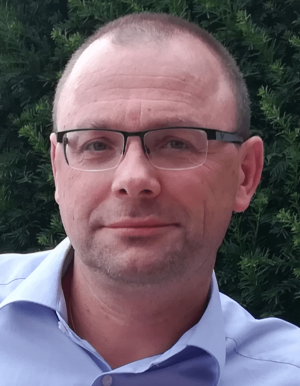
Portrait Prof. Buchmeiser
Foto: Prof. Dr. Michael BuchmeiserCurriculum Vitae
Michael R. Buchmeiser received his Ph. D. in Organometallic Chemistry in 1993 from the University of Innsbruck, Austria (Prof. Dr. H. Schottenberger). He was awarded an “Erwin Schrödinger Fellowship” and spent one year at the MIT within the group of Prof. Richard R. Schrock (Chemistry Nobel Prize 2005). In 1998, he finished his “Habilitation” in Macromolecular Chemistry at the University of Innsbruck were he then held a Faculty Position as Associate Professor from 1998-2004. From 2000-2001, he was Visiting Professor at the Graz University of Technology, Austria. In 2004 he accepted a Faculty Position (C-4 Professor) at the University of Leipzig, Germany. In addition, from 2005-2009, he served as Vice Director and Member of Board at the Leibniz Institute of Surface Modification (IOM), Leipzig, Germany. He was offered Faculty Positions (Full Professor of Polymer Chemistry) from the University of Halle (Germany, 2004), from the University of Leoben (Austria, 2005), from the TU Dresden (Germany, 2007), and from the Saarland University, Germany, in combination with the position of the Scientific Director of the Leibniz-Institute of New Materials (INM, 2012), which he all declined. Since 2009, he holds a Faculty Position (Full Professor) at the University of Stuttgart (Germany) and is Member of the Board of Directors at the German Institutes of Textile and Fiber Research (DITF) Denkendorf. Since 2018, he is also spokesperson of the Collaborative Research Center CRC 1333 “Molecular Heterogeneous Catalysis in Confined Geometries”. His research interests are located in the area of polymer synthesis, particularly polymerization catalysis, the synthesis of functional polymeric materials, e.g., for molecular heterogeneous catalysis, polymers for batteries or for fiber-matrix composites as well as in the manufacturing of high-performance fibers, in particular of carbon and ceramic fibers. In addition, he is also interested in aspects of reaction engineering for continuous, both metal-catalyzed heterogeneous and biocatalysis. So far, he has published more than 350 research papers and has filed more than 40 patents. For his scientific work, he received the “Professor Ernst Brandl Research Award 1998”, the “START Award-2001” the “Novartis Award 2001” as well as the “Otto-Roelen Medal of the German Catalytic Society”.
Learn more about Prof. Dr. Michael BuchmeiserExterner Link
Abstract
Cycle-Stable, High Capacity Metal-Sulfur Batteries
Based on Sulfur/Poly(acrylonitrile) (SPAN) Cathodes
Michael R. Buchmeiser
Chair of Macromolecular Compounds and Fiber Chemistry,
Institute of Polymer Chemistry, University of Stuttgart, Germany
michael.buchmeiser@ipoc.uni-stuttgart.de
Lithium-sulfur (Li-S) and magnesium-sulfur (Mg-S) batteries are among the most promising next-generation energy storage systems.1 Despite a lower operating voltage in Mg-S batteries compared to Li-S batteries, Mg-S batteries offer a higher volumetric energy density and higher safety. Generally, conventional metal sulfur batteries require high amounts of redox-inactive liquid electrolytes, which do not contribute to cell capacity. Thus, the practical specific energy of these batteries is often comparably poor (≤500 Wh/kg) and barely competitive with existing, high-end Li-ion batteries. This talk will address the latest accomplishments in both, Li- and Mg-S batteries. Generally, sulfurized poly(acrylonitrile) (SPAN) was used as cathode materials. In contrast to most other cathode materials, it contains sulfur chemically bound to a semiconductive polymeric matrix. The special nature of SPAN with its vinylogous/phenylogous enolic thioamides allows for a cycle-stable discharge/charge over more than 1200 cycles up to rates of 8C. Hybrid metal-sulfur batteries that contain both a liquid and a solid cathode, i.,e. dimethyl trisulfide (DMTS) and SPAN, have been prepared.2-6 These exhibit high capacity (formally, when referring solely to the sulfur in the cathode, up to 7100 mA.h/gsulfur of cathode), high areal capacity up to 4.3 mA.h.cm-2, high rate capability up to 8 C and excellent cycle stability (>700 cycles).7 In addition, both the working and aging mechanism have been elucidated by NMR, Raman, X-ray photoelectron and electronic impedance spectroscopy, X-ray powder diffraction, cyclic voltammetry, and post-mortem analysis. Generally, the working and aging mechanisms differ substantially from those of sulfur@carbon cathodes8 and allow even the use of carbonate-based electrolytes.9 Implications on Mg-S batteries will be presented, too.
References
- X. Ji, K. T. Lee, L. F. Nazar, Nature Mater., 2009, 8, 500.
- J. Wang, J. Yang, J. Xie, X. Naixin, Adv. Mater. 2002, 14, 963.
- J. Fanous, M. Wegner, J. Grimminger, Ä. Andresen, M.R. Buchmeiser, Chem. Mater. 2011, 23, 5024.
- J. Fanous, M. Wegner, J. Grimminger, M. Rolff, M.B.M. Spera, M. Tenzer, M.R. Buchmeiser, J. Mater. Chem. 2012, 22, 23240.
- J. Fanous, M. Wegner, M. B. M. Spera, M. R. Buchmeiser, J. Electrochem. Soc., 2013, 160, A1169.
- M. Frey, R. K. Zenn, s. Warneke, K. Müller, A. Hintennach, R. E. Dinnebier, M. R. Buchmeiser, ACS Energy Lett. 2017, 2, 595.
- S. Warneke, R. Zenn, T. Lebherz, K. Müller, A. Hintennach, U. Starke, R. E. Dinnebier, M. R. Buchmeiser, Adv. Sust. Syst. 2018, 2, 1700144.
- S. Warneke, M. Eusterholz, R. Zenn, A. Hintennach, R. E. Dinnebier, M. R. Buchmeiser, J. Electrochem. Soc. 2018, 165, A6017.
- S. Warneke, A. Hintennach, Michael R. Buchmeiser, J. Electrochem. Soc, 2018, 165, A2093.
